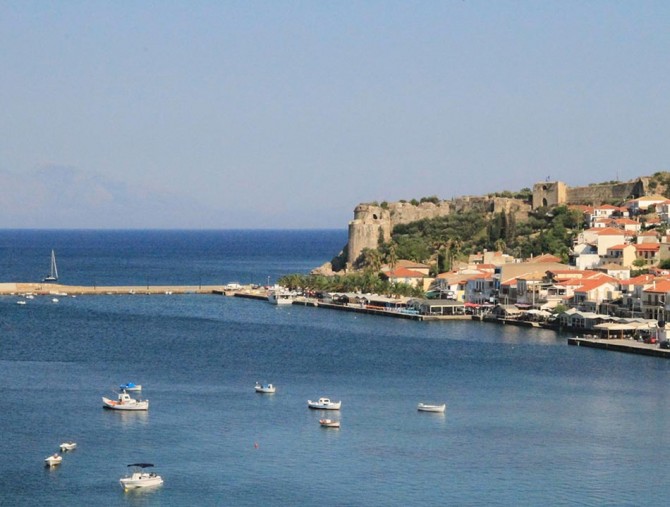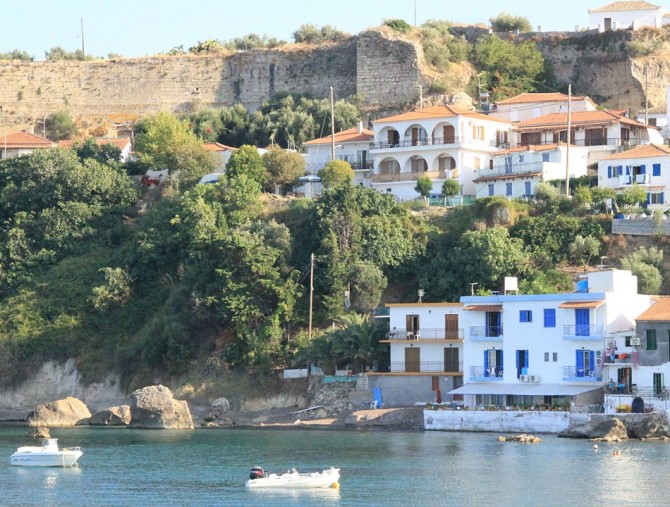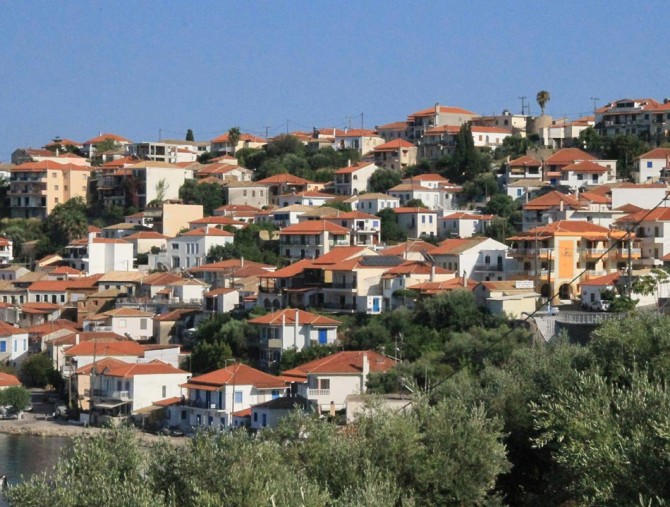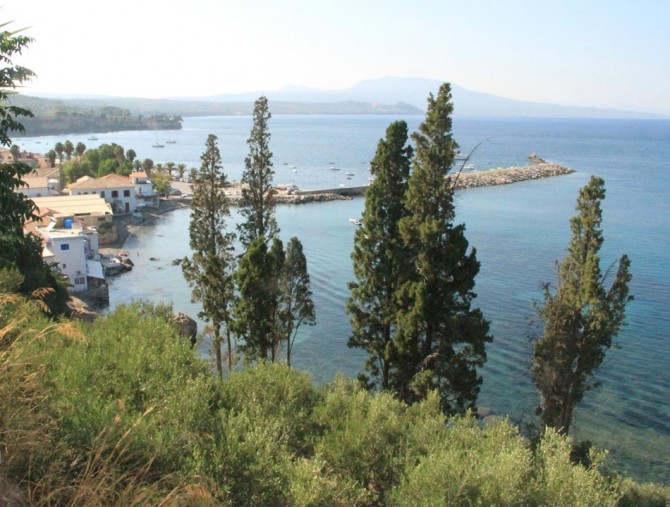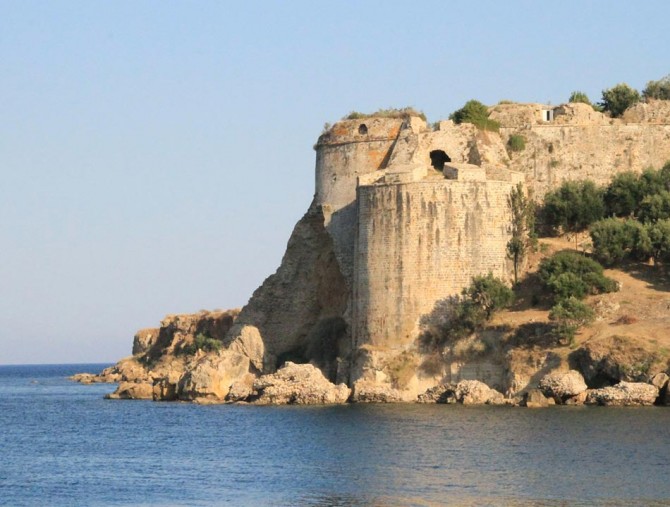Корони
Главная достопримечательность этого места - средневековый замок, а вернее - крепость, построенная в VI веке. Это один из лучших примеров венецианской архитектуры. Удивительно, но факт - эта крепость обитаема. И конечно же тут немало артефактов византийской эпохи, например, монастырь, выстроенный на месте Храма Аполлона. Также стоит обратить внимание на византийский Храм Святой Софии, построенный в XII веке. Что касается территории, которая к крепости не относится, то тут можно выделить Храм Панагии Елестрия. Этот храм был построен в 1897 году на месте, где была найдена икона Святой Матери.
Основная часть таверн и кафе в городе находится на набережной. Тут же, неподалеку, расположено немало неплохих пляжей. Это песчаные пляжи Загка, Меми и Каламаки - в последнем можно увидеть останки старого корабля. Пляж Перулия отличается от прочих тем, что тут находятся множество баров. Колонидес - место тихое и уединенное, а Гаргару - это лучший галечный пляж в округе. Что же касается мест для купания с лучшим видом, то это - Замок Корони. Отсюда можно видеть знаменитую крепость.
В период с июня по октябрь в Карони проводится масса интересных фестивалей. Самый интересные из них - это фестивали классической и современной музыки, также устраиваются поэтические чтения и проходят выставки современного искусства.
Как добраться до Корони:
- на машине из Афин (274 км) по трассе А7
- на машине из Каламаты (51 км) по местной трассе Ризомилос-Корони
- на автобусе из Афин (через Каламату) с автовокзала Кифисью
- на автобусе из Каламаты, тел. станции: +30 27210 28 581, тел. станции в Корони: +30 27250 22 231
- на поезде из Афин (до Каламаты) с ж\д вокзала Лариссис (метро Лариссис), тел. вокзала Лариссис: +30 210 52 97 777, тел. вокзала в Каламате: +30 27210 95 006/95 056
- на самолете из Афин (до Каламаты) из аэропорта Элефтериос Венезелос, тел. аэропорта Каламаты: +30 27210 63 805
- на пароме из Пирея до Каламаты, тел. порта Каламаты: +30 27210 22 218
Tекст: Александр Фролов
Koroni
Known as one of the most beautiful seaside towns of the Prefecture of Messinia, Koroni is one of the places you will definitely want to visit in south Peloponnese. Extraordinary beaches, amazing nature, traditional houses with flower filled yards and a famous Venetian castle consist an irresistible combination. After all, Koroni was popular and wanted by all since forever...
In the antiquity, was a powerful and rich city, due to its strategic geographical position. It had temples, palaestras and statues, port and coin. Its name back then was initially Rio and later Assini. Between the 5th and the 6th century BC it took the name Koroni, after the Koronians who settled in the area. In the Byzantine times, Koroni was still a powerfull city with a castle, being at the crossroad of influences, conflicts and political currents between East and West who wanted to dominate the area. In 1207 AD, the Venetians managed to prevail, and for the next 300 years Koroni became a naval and commercial center. That was the golden age of the city. Those years, Koroni, along with the neigbouring Methoni, were known as the “Eyes of Venezia”. From 1500 until 1821, the Turks and the Westerners kept fighting for Koroni. After the liberation, the people of Koroni turned to the land, the sea, the trade and the crafts, continuing the tradition of
centuries.
The famous Venetian castle of Koroni was built in the 6th century AD and is one of the finest samples of Venetian fortress architecture. It is also one of the few Greek castles that are still residential. Inside the castle there are a few churches that worth a visit. About 150 meters after you enter the central gate, you will meet the monastery of St. John the Baptist, which is a nunnery that follows the Old Calendar, built in 1918 at the site of an ancient temple of Apollo. The monastery facilities include a few caves which are carved into the wall. The most famous of them is called “School”and reminds catacomb. In the area of Monastery, among the ancient remnants, there is also the beautiful Byzantine church of Hagia Sophia, built in the 12th century, with an amazing interior design.
Outside the castle, in the southwestern end, you will meet the glorious church of Panagia Eleistria (Merciful), who is the patron saint of Koroni. It was built in 1897 in the place where the miraculous icon of the Mother of God was found. Besides the pilgrimage in the holy place, you will also have the chance to admire an outstanding view to the entrance of the Messenian Gulf and the sandy bay of Koroni, which is framed by the island Venetiko to the west and by the mount Taygetos to the east.
The central traditional square of Koroni hosts the metropolitan Church of St. Demetrios., which is a basilica of Ionian style, built in 1864. In the dreamy small palm forest located next to the church, there is the statue of Bishop Gregory and the building of the Historical and Archaeological Collection of Koroni, that houses archaeological findings of the area.
The coastal road of Koroni, besides the breathtaking view to the Messenian Gulf and the imposing mountain of Taygetos, is framed by dozens of cafes and taverns, where you can sit after you enjoy your dives in the crystal clear waters of the magical beaches. Mark the names: Zagka: wonderful, endless, lively and organized sandy beach. Memi: Organized, with sport facilities, golden sand and crystal clear waters. Kalamaki: One of the most popular, with fine sand, turquoise waters and a rusty ship wreck as an extra bonus. Peroulia: Popular, long, with golden fine sand and a beach bar. Kolonides: Beautiful, quiet, with very fine, golden sand, surrounded by rocks and trees. Gargarou: Quiet, narrow, with brown pebbles. Castle of Koroni: Beautiful and small, with pebbles and small rocks, and an amazing view to the Venetian castle.
If you visit Koroni between June and October, you will also have the chance to attend to the Koroni Festival which is organized annually in this period, including Classical Music - Opera , modern and traditional music, poetry, dance, theater and visual arts exhibitions.
How to get there: By car from Athens (distance 274 km) via A7, from Kalamata (distance 51,6 km) via Provincial Road Rizomylos-Koroni. By bus from Athens and Kalamata: Athens bus station (100 Kifissou Avenue, Athens), tel.: +30 210 52 33 810 /51 34 293. Kalamata bus station (Artemidos street, Kalamata), tel.: +30 27210 28 581. Koroni bus station, tel.: +30 27250 22 231. By train from Athens to Kalamata (and by bus to Koroni). Larissis Train Station, Diligianni & Domokou street, Athens), tel.: +30 210 52 97 777. Kalamata Train Station, tel.: +30 27210 95 006/95 056. By air from Athens to Kalamata (and by bus to Koroni). International Aiport Eleytherios Venizelos (Spata, Athens), tel.: +30 210 35 30 000. Kalamata airport, tel.: +30 27210 63 805. By ship from Piraeus to Kalamata (and by bus to Koroni). Piraeus port, tel.: +30 210 41 47 800. Kalamata port, tel.: +30 27210 22 218.
Τext: Marilou Pantazi

